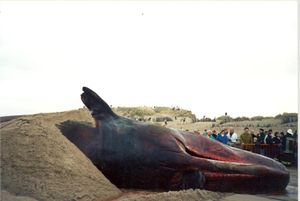PCB and heavy metals in beached sperm whales
Heavy Metals, Organochlorines and Polycyclic Aromatic Hydrocarbons in Sperm Whales Stranded in the Southern North Sea During the 1994/1995 Winter
Context of the study
In the winter of 1994-1995 21 sperm whales beached along the North Sea shorelines. The reason for the mass strandings was that these sperm whales became trapped as a group in the unfavorable North sea. Because of the unfavorable conditions in the North Sea the animals starved and ultimately stranded. However, these animals can be used to obtain valuable information on accumulation and excretion mechanics of stable pollutants and the overall health status of these long-living marine mammals.
Content of the study
7 of the 21 sperm whales beached on Belgian and Dutch territory. One of them died at least a day before beaching, the six others died shortly after stranding. The muscles, livers kidneys and fat of these 7 whales were examined for the presence of heavy metals, organochlorines and PAH's.
Main results
High concentrations of cadmium (up to 300 µg/g dry weight in the kidney), total mercury (up to 130 µg/g dry weight in the liver) and PCB's (up to 5 µg/g in blubber) were retrieved in these sperm whales. It's remarkable that less than 66% of the Cd found in the livers and kidney's were bound to metallothioneins. Therefore the remaining 33% might not have been detoxified. This is in contradiction to findings from the Pacific Ocean where 90% of the Cd has been found to be bound to metallothioneins. Methylmercury averaged 4% of total mercury concentrations in the liver and 90% in the muscles.
You can find more information of this study though this link
